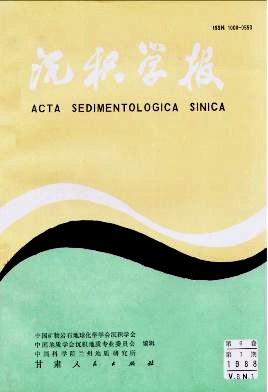QUARTZ CEMENTATION IN QUARTZOSE SANDSTONE AND ITS INFLUENCE ON SANDSTONE POROSITY
- Received Date: 1986-01-13
- Publish Date: 1988-03-10
Abstract: Recording to fades analysis, Taiyuan Formation of the upper Carboniferous in the region of Henan Province and Shandong Province, northern part of China, is deposited in sea inlet, tidal flat and shore marsh. The sandstones of Taiyuan Formation are mainly pure quartzose sandstones, deposited on the shoreface beach, tidal flat or other high energy environments. They are originally of high maturity, both in texture and in composition. During the long geologic processes, sandstones have undergone deep and complex diagenesis, with the formation of large amount of auth-higenetic quartz in the form of overgrowth and the gradual loss of primary pores. Analytical results of cathodoluminescence petrography, scanning electron microscopy and X-ray microanalysis reveal that quartz cementation is the dominating process responsible for the loss of primary pores. Quartz cement occurs mainly as overgrowths, which have the same optical orientation with the detrital grains. Outlines of original grains are poorly visible, or completely undistinguishable for most overgrowth grains. Under these cicurmst-ances, only the cathodoluminescnce technique can be effective in brimging the shape of grains to light. By luminescence microscopy, the detrital quartz grains display either brown or blue colour, depending on their source rocks. The authigenetic quartz, however, usually shows no colour of luminescence, or has dark brown colour. Two generations of quartz overgrowth in the Taiyuan quartzose sandstones are recognizable from the luminescence difference and the location of quartz cement. The dark brown authigenetic quartz, along grain boundaries, or filled in grain cracks, represents the early stage of quartz cementation. The great amount of non-lumiescence quartz, welded around the early overgrowth quartzs, marks the late stage of quartz cementation. According to pointcount calculation under cathodoluminescence, the authigenetic quartz accounts for 16 percent of the total quartz. The ratio of the amounts of authigenetic quartz between the early stage and late stage is about 1/3. This shows that the late quartz cementation is strong and progressive. It is generally accepted that the source of the silica cement in pure quartz sandstone includes: pressure solution in sandstones, alteration of clay minerals and dissolutin of small guartz grains in associated siltstones, dissolution of some detrital grains such as feldspar and rock fragments, the migretion of undergroundwater etc. Cathedoluminescence study has proved that intergranular pressare solution occurs only partially and locally. Concequently, it has little significant influence on quartz cementation,or in other words it cannot be the main source of authigenetic quartz. The quartz cement derived from pressure solution, according to the point-count data, accounts for only 10 percent. X-ray diffraction analysis of clay minerals in Taiyuan Formation and the upper strata leads us to the idea that the silica released during the alteration of smectite to illite in adjacent mudstones may play an important role in quartz cementation. A possible explination of the generations of overgrowth quartz may be like this: at early stage of diagenesis, the limitted intergranular pressure solution may derive dissolved silica, which, then is precipitated on adjacent quartz grains, or fills some cracks; with increase of burial depth, alteration of clay minerals in interbedded mudstones becomes strongly discharg, silica slowly migrates into sandstone with pore fluid and is precipitated. The formation temperature of the authigenetic quartz is also analysized by determining the homogeneous temperature, of fluid inclusions in quartz cement. During the process of this work, the temperature history of the area, on the basis of the vitrinite reflectance in shales; was taken into account. Through careful studies, a definite formation temperature ranging from 140°C to 150°C is finally established for authigenetic quartz. The strong quartz cementation in sandstones of Taiyuan Formation not only leads to the
| Citation: | Zheng Junmao, Pang Ming. QUARTZ CEMENTATION IN QUARTZOSE SANDSTONE AND ITS INFLUENCE ON SANDSTONE POROSITY[J]. Acta Sedimentologica Sinica, 1988, 6(1): 29-38. |






 DownLoad:
DownLoad: